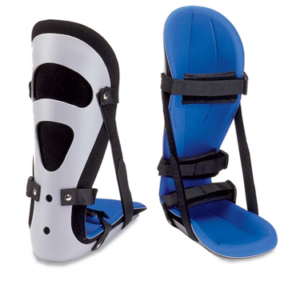Carbon fiber Vs. Thermoplastic in Prosthetics and Orthotics
There are two common types of materials that are used in the field of prosthetics and orthotics; these materials are thermoplastics and carbon fiber. Each of these types of materials have different uses and applications and are used based on the needs of each patient and the type of device they are receiving.
Carbon is among one of the most valuable materials used in orthopedic applications. Carbon is very light, rigid, and able to hold its shape under stress. This is due to its high tensile strength under both tension and compression. Carbon has a bi-directional woven pattern that allows for an increase in the fracture resistance, allowing for a uniform strength throughout the device (Berry). This means that the carbon socket (prosthetics) or the brace (orthotics) is very durable and can withstand a lot of pressure from patient use.
Carbon fiber is used in prosthetics for the definitive socket that the patient will receive after the test socket has been approved by the patient. The design of the socket is determined by the type of prosthesis that the patient is receiving and the patient and customize the outer design of the socket to their liking. In orthotics, carbon fiber is used based on the type of brace and activity level of the patient. Carbon fiber allows for increased rigidity in the brace which is needed for braces that allow for an articulating ankle or for braces that need increased stability.
The use of thermoplastics delivers many design improvements over carbon and other traditional systems due to design options that allow increased contact and support on the limb, simple fabrication process, a reduction in weight with retained strength, and cosmetic improvements allowing for a variety of options for color and decorative transfer patterns (Thermoplastics). Although thermoplastics are not as rigid as carbon fiber, they still offer man benefits for the patient and are a great option for patient use.
There are different types of plastics used in prosthetics and orthotics. For prosthetics, thermoplastics are used for diagnostic or test sockets for the patients when they are working out the fit of the socket before they are transferred to a carbon fiber socket. The thermoplastics used are Thermolyn also know and Orffitrans; commonly used for below the knee sockets, and Vivak also known as DurrPlex; commonly used in above the knee sockets.
There are 2 common thermoplastics used in orthotics; Copolymer and Polypropylene. Polypropylene, also known as Polypro, has high elasticity and stiffness and is good for producing very thin-walled, lightweight, and stable orthotic devices, although can be brittle and easily broken. Copolymer, also known and Copoly, has a high impact strength and is easily formed with low temperatures, which makes it easily adjustable to suit the patient’s needs (Smit).
These materials allow for the best possible device to be created for the patient, different strengths, rigidity and weights allow for a variety of options to create the best possible custom device based on the patient’s activity level and use of the device.
Works cited
Berry, D. A. (n.d.). Composite Materials for Orthotics and Prosthetics. Orthotics and Prosthetics,40(4), 35-43. Retrieved February 15, 2019.
Smit, E. (2014, March 4). Thermoplastic materials used in Orthotics and Prosthetics. Retrieved February 15, 2019, from
https://prezi.com/yr0h-jvqt_nn/thermoplastic-materials-used-in-orthotics-and-prostetics/
Thermoplastics for Orthotic and Prosthetic Devices and Components. (n.d.). Retrieved February 15, 2019, from
https://tamarackhti.com/blog/thermoplastics-for-orthotic-and-prosthetic-devices-and-components/




